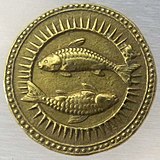Pisces (astrology)
| Pisces | |
|---|---|
 | |
| Zodiac symbol | twofish |
| Duration (tropical,western) | February 19 – March 20 (2024,UT1)[1] |
| Constellation | Pisces |
| Zodiac element | Water |
| Zodiac quality | Mutable |
| Sign ruler | Jupiter(traditional),Neptune(modern) |
| Detriment | Mercury |
| Exaltation | Venus |
| Fall | Mercury |
| Astrology |
|---|
 |
| Background |
| Traditions |
| Branches |
| Astrological signs |
| Symbols |
Pisces(♓︎) (/ˈpaɪsiːz/;[2][3]Ancient Greek:ἸχθύεςIkhthyes,Latin for "fishes" ) is the twelfth and finalastrological signin thezodiac.It is amutable sign.It spans 330° to 360° ofcelestial longitude.Under the tropical zodiac, thesuntransits this area between February 19 and March 20.[a]In classical interpretations, the symbol of the fish is derived from theichthyocentaurs,who aidedAphroditewhen she was born from the sea.[4]
According to some tropical astrologers, the current astrological age is theAge of Pisces,[5]while others maintain that currently it is theAge of Aquarius.
Background[edit]

While the astrological sign Pisces per definition runs fromecliptic longitude330° to 0°,[6]this position is now mostly covered by the constellation of Aquarius due to the precession from when the constellation and the sign coincided. Today, theFirst Point of Aries,or thevernal equinox,is in thePisces constellation.[7][3]There are no prominent stars in the constellation,[3]with the brightest stars being of onlyfourth magnitude.[8]One star in the constellation,Alpha Piscium,is also known as Alrescha, which comes from theArabic:الرشآء,romanized:al-rišā’,meaning "thewellrope ",[9]or "the cord".[8]The constellation, however, is different from the astronomical location where the sign occupies space. The constellations in earlier times were primarily used as markers to help determine what influence was in the sky. Nevertheless, the sign of Pisces remains in the 30-degree span of 330°–0°.
Ptolemydescribed Alpha Piscium as the point where the cords joining the two fish are knotted together.[8]The astrological symbol shows the two fishes captured by a string,[10][11][12][13]typically by the mouth or the tails.[14]The fish are usually portrayed swimming in opposite directions; this represents the duality within the Piscean nature. They are ruled by the planet Jupiter (Neptune in modern astrology).[10][15]Although they appear as a pair, the name of the sign in all languages originally referred to only one fish with the exception ofGreek,[16]Ukrainian, Polish, Romanian, Bulgarian, Russian, Dutch, Swedish, Hungarian, Latvian, Lithuanian, Italian and Portuguese. Pisces is themutablewater signof the zodiac.
Mythology[edit]
Divine associations with Pisces includePoseidon/Neptune,Aphrodite,Eros,Typhon,Vishnu[17]and the Sumerian goddessInanna.
In early mythology[edit]
"Pisces" is theLatinword for "fishes".[18]It is one of the earliest zodiac signs on record, with the two fish appearing as far back asc. 2300 BCon an Egyptian coffin lid.[19]
According to oneGreek myth,Pisces represents the fish, sometimes represented by ashark,into whichAphrodite(also consideredVenus)[20]and her sonEros(also consideredCupid)[20]transformed in order to escape the monsterTyphon.[3][21][18]Typhon, the "father of all monsters", had been sent byGaiato attack the gods, which ledPanto warn the others before himself changing into agoat-fishand jumping into theEuphrates.[8]A similar myth, one in which the fish "Pisces" carries Aphrodite and her son out of danger, is resounded inManilius' five-volume poetic workAstronomica:"Venus ow'd her safety to their Shape."[20]Another myth is that an egg fell into the Euphrates River. It was then rolled to the shore by fish. Doves sat on the egg until it hatched, out from which came Aphrodite. As a sign of gratitude towards the fish, Aphrodite put the fish into the night sky.[8]Because of these myths, the Pisces constellation was also known as "Venus et Cupido", "Venus Syria cum Cupidine", "Venus cum Adone", "Dione" and "Veneris Mater",[20]the latter being the formal Latin term for mother.
The Greek myth on the origin of the sign of Pisces has been cited by English astrologerRichard James Morrisonas an example of the fables that arose from the original astrological doctrine, and that the "original intent of [it] was afterwards corrupted both by poets and priests."[21]
In modern mythology and religion[edit]
Purim,aJewish holiday,falls at the full moon preceding the Passover, which was set by the full moon in Aries, which follows Pisces.[22]The story of the birth of Christ is said to be a result of the spring equinox entering into the Pisces, as the Savior of the World appeared as the Fisher of Men. This parallels the entering into the Age of Pisces.[23]
Astrological age[edit]

An astrological age is a time period inastrologythat parallels major changes in the development of Earth's inhabitants, particularly relating to culture, society and politics, and there are twelve astrological ages corresponding to the twelve zodiacal signs. Astrological ages occur because of a phenomenon known as theprecession of the equinoxes,and one complete period of this precession is called aGreat Yearor Platonic Year[24]of about 25,920 years.
The age of Pisces beganc. AD 1and will endc. AD 2150.[b]With the story of the birth ofChristcoinciding with this date,[25]many Christian symbols for Christ use the astrological symbol for Pisces,[26]the fishes.[27]The figure Christ himself bears many of the temperaments and personality traits of a Pisces,[28]and is thus considered anarchetypeof the Piscean.[29]Moreover, thetwelve apostleswere called the "fishers of men", early Christians called themselves "little fishes", and a code word for Jesus was the Greek word for fish, "ΙΧΘΥΣICHTHYS".[27]With this, the start of the age, or the "Great Month of Pisces", is regarded as the beginning of the Christian religion.[30]Saint Peteris recognized as theapostleof the Piscean sign.[31]
In the arts[edit]

Venus exalted in Pisces is representative of divine love in the firstcantoofDante'sPurgatorio.[32]Pisces is the subject ofLuca Della Robbia's 15th centuryPlate with the Month of February.[33]They are also the subject of one ofElizabeth Barrett Browning's poetic works:[34]
And here fantastic fishes duskly float,
Using the calm for waters, while their fires
Throb out quick rhythms along the shallow air.— Elizabeth Barrett Browning,A Drama of Exile
In popular culture[edit]
In the January 1970 edition of theAvengers(No. 72), thesupervillaingroupZodiacintroduced the member "Pisces"whose abilities allowed him to live underwater, which included fins, scales and gills.[35]
In the 1979 sports fantasy filmThe Fish That Saved Pittsburgh,the fictitiousbasketball teamthe "Pittsburgh Pythons" turn to astrology after a continuous losing streak, and fill the roster with players born under the astrological sign of Pisces. They are reborn as the "Pittsburgh Pisces" and enter into a championship.[36]
Gallery[edit]
-
Depicted in 14th century Arabic manuscript,Book of Wonders
-
Appearing inChartres CathedralinChartres
-
16th-centurywoodcutbyJohannes Regiomontanus
-
Depicted in a 14th western BritishBook of Hours
-
A representation of the Pisces symbol
See also[edit]
References[edit]
Notes[edit]
- ^The dates during which the sun is in Pisces, as with all the signs, is dependent on the leap year cycle; the dates February 19 to March 20 are given byEncyclopedia Britannica.[18]Other sources give the beginning on February 20,[2]and ending on March 21.[37]
- ^There are some discrepancies in when the astrological ages begin and end. The variation in the "Age of Pisces" is said to be from AD 1 until AD 2150, AD 498 to AD 2654, and 100-90 BC until AD 2680 according to the interpretations of Neil Mann, Heindel Rosicrucian, and Shephard Simpson, respectively.
Citations[edit]
- ^Astronomical Applications Department 2011.
- ^abOxford University Press.
- ^abcdO'Shea, Ellsworth & Locke 1920,p. 4638.
- ^Atsma 2017.
- ^Nicholas Campion,(1988)The Book of World HoroscopesAquarian Press, WellingboroughISBN0-85030-527-6
- ^Louis 1998,p. 169.
- ^Ridpath 2001,pp. 84–85.
- ^abcdeStar Tales.
- ^Allen 1899,p. 538.
- ^abLeo 1899,p. 39.
- ^Roback 1854,p. 41.
- ^Hutton 1815,p. 368.
- ^Cross Smith 1828,p. 57.
- ^Mowat, Cooper & MacTavish 1903,p. 34.
- ^Guttman, Guttman & Johnson 1993,p. 359.
- ^Allen 1899,p. 338.
- ^Battistini 2007,p. 62.
- ^abcBritannica.com.
- ^Guttman, Guttman & Johnson 1993,p. 357.
- ^abcdAllen 1899,p. 339.
- ^abThe Metropolitan 1834,p. 94.
- ^Bobrick 2006,p. 9.
- ^Bobrick 2006,p. 10.
- ^Spencer 2000,p. 116.
- ^Freke & Gandy 2001,Myth becomes History.
- ^Scott 1996,p. 73.
- ^abFreke & Gandy 2001,The New Age.
- ^Ankerberg 2011,10.
- ^Guttman, Guttman & Johnson 1993,p. 360.
- ^Freke & Gandy 2001,The Greatest story ever told.
- ^The Open Court 1920,p. 300.
- ^Bobrick 2006,p. 114.
- ^Battistini 2007,p. 63.
- ^Allen 1899,p. 336.
- ^Marvel Universe Appendix.
- ^The Fish That Saved Pittsburgh.
- ^Carey & Perry 2003,p. 308.
Sources[edit]
- Allen, Richard Hinckley(1899),Star-names and their meanings,G. E. Stechert,OCLC1285139
- Ankerberg, John (2011),The Facts on Astrology,ISBN9781937136154
- Astronomical Applications Department (2011).Multiyear Computer Interactive Almanac.2.2.2. Washington DC: US Naval Observatory.Longitude of Sun, apparent geocentric ecliptic of date, interpolated to find time of crossing 0°, 30°....
- Atsma, Aaron (2017),"ICHTHYES (Ichthyes) - Fish of Aphrodite in Greek Mythology",Theoi.com,retrieved8 October2017
- Battistini, Matilde (2007),Astrology, Magic, and Alchemy in Art,Getty Publications,ISBN9780892369072
- Bobrick, Benson (2006),The Fated Sky: Astrology in History,Simon & Schuster,ISBN9780743268950
- Cainer, Jonathon(1999),The Complete Book of the Zodiac,Sterling Publishing Company, Inc.,ISBN9780806959221
- Carey, George W.;Perry, Inez Eudora (2003),Zodiac,Kessinger Publishing,ISBN9780766138063
- Carus, Paul, ed. (1920),The Open Court,vol. 34, The Open Court Pub. Co.,OCLC1761311
- Constellation of Pisces,International Astronomical Union,retrieved4 December2012
- Cross Smith, Robert(1828),A manual of astrology, or the book of the stars,OCLC243960206
- "The Fish That Saved Pittsburgh",Plot Summary,IMDb,retrieved1 January2013
- Freke, Timothy;Gandy, Peter(2001),The Jesus Mysteries: Was the "Original Jesus" a Pagan God?,Random House Digital, Inc.,ISBN9780609807989
- Guttman, Ariel; Guttman, Gail; Johnson, Kenneth (1993),Mythic Astrology: Archetypal Powers in the Horoscope,Llewellyn Worldwide,ISBN9780875422480
- Hutton, Charles(1815),A Philosophical and Mathematical Dictionary,OCLC557643793
- Leo, Alan(1899),Astrology for all: to which is added a complete system of predictive astrology for advanced students,L.N. Fowler & Co,OCLC796904382
- Louis, Anthony (1998),Horary Astrology Plain & Simple: Fast & Accurate Answers to Real World Questions,For Beginners Series, Llewellyn Worldwide,ISBN9781567184013
- The Metropolitan,vol. 10, James Cochrane, 1834,OCLC58892017
- Mowat, J. Gordon; Cooper, John Alexander; MacTavish, Newton (1903),The Canadian Magazine of Politics, Science, Art and Literature,Ontario Publishing Company, Limited,OCLC1553181
- O'Shea, Michael Vincent; Ellsworth, Decatur Foster;Locke, George Herbert(1920),The world book: organized knowledge in story and picture,vol. 8, W.F. Quarrie & Co,OCLC707067037
- Pisces,Marvel Universe Appendix,retrieved22 January2013
- Pisces,Britannica.com Inc.,retrieved13 December2012
- Pisces,Oxford University Press,archived fromthe originalon July 18, 2012,retrieved23 December2018
- Ridpath, Ian(2001),Stars and Planets Guide,Princeton University Press,ISBN9780691089133
- Ridpath, Ian,"Pisces the fishes",Star Tales,retrieved8 December2012
- Roback, Charles W. (1854),The mysteries of astrology and the wonders of magic,OCLC609243056
- Scott, John P. (1996),The Four Gospels,Health Research Books,ISBN9780787307516
- Shapiro, Lee (1977)."The real constellations of the zodiac".International Planetarium Society.Retrieved19 February2019.
- Spencer, Neil (2000),True as the Stars Above,London: Victor Gollancz
External links[edit]
 The dictionary definition ofPiscesat Wiktionary
The dictionary definition ofPiscesat Wiktionary Media related toPiscesat Wikimedia Commons
Media related toPiscesat Wikimedia Commons Quotations related toPiscesat Wikiquote
Quotations related toPiscesat Wikiquote- Pisces Zodiac Sign
- Warburg Institute Iconographic Database (ca 340 medieval and early modern images of Pisces)








